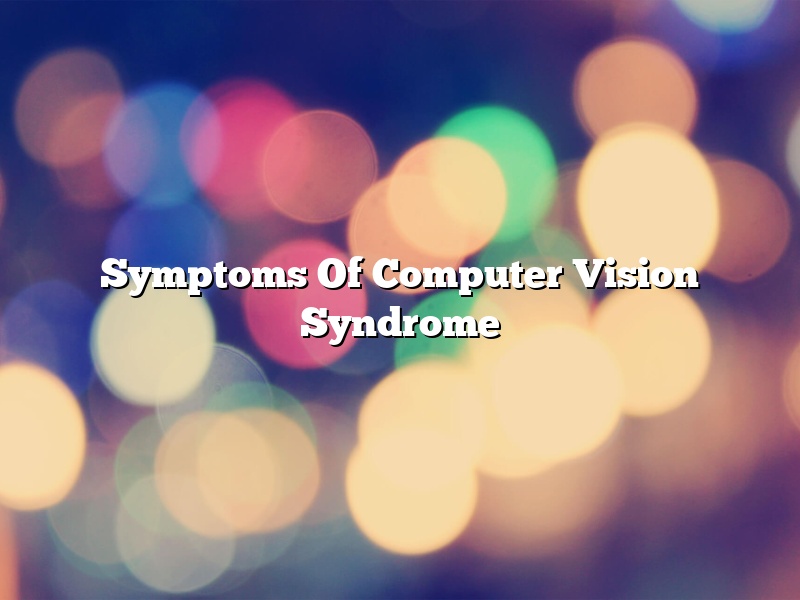Symptoms of computer vision syndrome (CVS) can include eyestrain, headache, blurred vision, dry eyes, and neck and shoulder pain. These symptoms can be caused by spending prolonged periods of time looking at a computer screen.
CVS is a condition that can be treated with eye drops, prescription glasses, and/or computer glasses. If you are experiencing any of the symptoms of CVS, it is important to see an eye doctor to determine the best treatment for you.
Contents
- 1 What are 3 symptoms of eyestrain in use of computer?
- 2 How long does computer vision syndrome last?
- 3 What is the fastest way to get rid of PC vision syndrome?
- 4 Is computer vision syndrome serious?
- 5 Will computer vision syndrome go away?
- 6 Do glasses help computer vision syndrome?
- 7 How is computer vision syndrome diagnosed?
What are 3 symptoms of eyestrain in use of computer?
Computer eyestrain is a common problem that can occur when using a computer for extended periods of time. Symptoms of eyestrain can include headache, blurred vision, dry eyes, and eye fatigue. Here are three common symptoms of eyestrain when using a computer:
1. Headache: A headache is one of the most common symptoms of eyestrain. Tension headaches are the most common type of headache associated with computer use.
2. Blurred vision: Blurred vision is another common symptom of eyestrain. It can be caused by your eyes having to work harder than normal to focus on the computer screen.
3. Eye fatigue: Eye fatigue is a feeling of tiredness in the eyes that can be caused by extended computer use. It can lead to symptoms such as eye irritation, dry eyes, and difficulty focusing.
How long does computer vision syndrome last?
Computer vision syndrome (CVS) is a condition that results from prolonged computer use. Symptoms can include eyestrain, headaches, blurred vision, and dry eyes. CVS can last for a few hours or a few days.
There are several things you can do to reduce the risk of CVS. First, take breaks every 20 minutes or so. Get up and walk around, or look away from the computer and focus on something in the distance. Second, make sure your computer workstation is set up properly. The screen should be about an arm’s length away, and the top of the screen should be at eye level. Third, use a good quality screen filter. This will help reduce glare and eyestrain.
If you are experiencing symptoms of CVS, there are a few things you can do to relieve the symptoms. First, use artificial tears or eye drops to relieve dry eyes. Second, use a cold compress to reduce eye fatigue. Third, take ibuprofen or another over-the-counter pain reliever to reduce headaches. Finally, get more rest. If you’re getting enough sleep, you’re less likely to experience CVS symptoms.
CVS is a common condition that can be easily treated. If you experience symptoms, see your doctor or optometrist for advice.
What is the fastest way to get rid of PC vision syndrome?
If you’re like most people, you spend hours each day looking at a computer screen. And over time, this can lead to what’s known as PC vision syndrome – a condition that can cause eye fatigue, headaches, and even vision problems.
Fortunately, there are several things you can do to get rid of PC vision syndrome and protect your eyes. One of the best ways to prevent PC vision syndrome is to take breaks every 20 minutes or so. During these breaks, you can look away from your screen and focus on something else for a few minutes.
Another good way to reduce your risk of PC vision syndrome is to make sure your computer screen is properly adjusted. The top of the screen should be at eye level, and the screen should be about an arm’s length away from your eyes.
You can also improve your vision by wearing glasses or contacts that correct for nearsightedness or farsightedness. And if you already have PC vision syndrome, you can treat it with eye drops or other medications.
So if you spend a lot of time in front of a computer, be sure to follow these tips to help protect your eyes.
Is computer vision syndrome serious?
Computer vision syndrome (CVS) is a condition that has been increasing in prevalence as more people spend extended periods of time in front of a computer screen. Symptoms of CVS include eye fatigue, dry eyes, headaches, and blurred vision. While the majority of people who experience CVS will only experience mild symptoms, for some the condition can be quite serious.
CVS is thought to be caused by the combination of factors such as staring at a screen for long periods of time, poor lighting, and dehydration. The blue light emitted from computer screens is also thought to play a role in CVS, as it can cause eye fatigue and other symptoms.
There are a number of measures that can be taken to help prevent or lessen the symptoms of CVS. These include taking breaks every 20 minutes, blinking frequently, using a humidifier, and using glasses that block blue light. If symptoms are severe, a doctor may prescribe eye drops or other medications.
Overall, computer vision syndrome is a relatively mild condition for most people. However, for some it can be quite serious. There are a number of steps that can be taken to help prevent or lessen the symptoms of CVS.
Will computer vision syndrome go away?
Most people who spend a lot of time looking at a computer screen will eventually experience some symptoms of computer vision syndrome (CVS). These symptoms can include eye fatigue, headaches, blurred vision, and dry eyes. While there is no cure for CVS, there are treatments that can help lessen the symptoms. In some cases, the symptoms will go away on their own after a person takes a break from using the computer.
Do glasses help computer vision syndrome?
Do glasses help computer vision syndrome? This is a question that many people who wear glasses have asked themselves at one point or another. The answer, unfortunately, is not a simple one.
There is some evidence that suggests that wearing glasses may help to alleviate some of the symptoms of computer vision syndrome (CVS), such as eye fatigue, blurred vision, and headaches. However, not all studies agree on this point, and more research is needed to determine whether or not glasses actually help to improve symptoms in people who suffer from CVS.
One possible reason why glasses may help to improve symptoms of CVS is that they help to reduce the amount of glare that is present on the screen. Glare can cause eye fatigue and headaches, and can also make it difficult to see the screen properly. By reducing the amount of glare, glasses may help to improve symptoms in people who suffer from CVS.
Another possible reason why glasses may help to improve symptoms of CVS is that they help to keep the eyes aligned properly. When the eyes are not properly aligned, this can lead to eye fatigue and headaches. By keeping the eyes aligned, glasses may help to reduce the amount of strain that is placed on the eyes, and may help to improve symptoms in people who suffer from CVS.
Despite the potential benefits that glasses may have for people with CVS, it is important to keep in mind that not everyone who suffers from CVS will experience relief from symptoms when they start wearing glasses. Additionally, glasses may not be the right solution for everyone, and some people may prefer to try other methods of alleviating symptoms, such as using an eye drop or computer glasses.
In conclusion, while there is some evidence that suggests that glasses may help to improve symptoms of CVS, more research is needed in order to make a definitive statement about whether or not this is the case. If you suffer from CVS, it is worth trying glasses to see if they help to improve your symptoms. However, if glasses do not help, do not hesitate to try other methods of alleviating your symptoms.
How is computer vision syndrome diagnosed?
Computer vision syndrome is a relatively new term that is used to describe a range of eye and vision-related problems that are caused or worsened by prolonged computer use. While the symptoms of computer vision syndrome can vary from person to person, they often include eyestrain, headaches, blurred vision, and dry eyes.
If you are experiencing any of these symptoms, your doctor may diagnose you with computer vision syndrome. In order to do so, he or she will ask you a series of questions about your computer use and will perform a series of vision tests.
If you are diagnosed with computer vision syndrome, your doctor may recommend a number of treatments, including eye drops, computer glasses, and changes to your computer workstation. By following your doctor’s recommendations, you can often lessen or eliminate the symptoms of computer vision syndrome.



